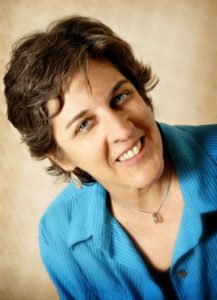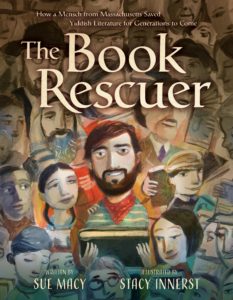Last year I had the incredible opportunity to visit the Yiddish Book Center to attend the TENT program for children’s authors. I could barely contain my excitement when I heard about THE BOOK RESCUER by Sue Macy, illustrated by Stacy Innerst (Paula Wiseman, Simon & Schuster). The book cover says it all – How a Mensch from Massachusetts Saved Yiddish Literature for Generations to Come. That mensch is Aaron Lansky, founder of the Yiddish Book Center. His story is both inspiring and heart-warming. It was a pleasure to meet Aaron in person and an equal pleasure to interview Sue Macey, the author of THE BOOK RESCUER.
THE BOOK RESCUER is such an inspiring story. How did you learn about Aaron Lansky and his mission to save Yiddish Books?
I think the first time I heard about the Yiddish Book Center was years ago, when my parents donated money to it and my aunt sent in some of her Yiddish books. But my interest in writing about the Book Center coalesced after my father died in 2013. My mother, brother, and I were making donations from a charitable fund my parents had established, and as I lobbied to include the Book Center, I started thinking about how great it would be to share Aaron’s story with kids. Books are so prominent in kids’ lives, so I believed they could really understand Aaron’s mission to save Yiddish books. The topic is a departure for me, since I usually write about women’s and sports history. But I wrote my senior thesis in college on an early 20th-century Jewish social reformer (Alice Davis Menken) and I was at the point in my career where I was ready to return to a Jewish subject.

Have you been to the Yiddish Book Center? If so, how did you feel being in the space that is so connected to your work?
I visited the Yiddish Book Center once when I started working on my book, once later on to attend a program on Jewish photographers in the 20th century, and then again last spring to participate in a panel discussion about The Book Rescuer. The first time I walked through the door I felt at home. It’s a very comfortable place, part library, part museum, part gathering space. The grounds are lovely, too, with areas dedicated to various Yiddish authors and poets. I couldn’t wait to bring my mom there. When she visited last April she had a ball.
Tell me about the research you did for this book. What was the most interesting thing you discovered that is not included in the final text?
The first thing I did was read Aaron’s book, Outwitting History, which is a wonderful, personal history of the Yiddish Book Center and gave me a terrific foundation from which to do other research. I also read newspaper and magazine articles about the Center and other things Aaron wrote, interviewed Aaron and Lisa Newman, the Center’s director of communications, and talked to Amanda Seigel, who is a Yiddish literature expert at the New York Public Library and performs Yiddish songs under the name Miryem-Khaye Seigel.
One thing that informed the text, but didn’t make it into the book directly, was Aaron’s statement to me that Judaism is more than just a religion. He said, “We are a people who have a culture that’s so all-encompassing that we also have our own religion.” When I went to Hebrew school we studied Hebrew, religion, and some very ancient biblical history. There was nothing about more modern Jewish literature, history, or music. It seemed as though unless you were religious, you were not really a Jew. Aaron’s statement helped me become comfortable with my own identity as a non-religious Jew in a way I hadn’t been before. Suddenly, everything made sense.
What were your thoughts when you first saw Stacy Innerst’s illustrations?
I was blown away by his illustrations, both the pictures themselves and the emotions they conveyed. They reminded me of the work of Marc Chagall, and of course later I found out that was Stacy’s inspiration. He talks about it in the eloquent Illustrator’s Note in the back of the book. There are a few spreads in particular that are extraordinary—I think my favorite is the shtetl with the Yiddish text covering the landscape. I also like that he included a cat, since I’m a cat lover. Though I had nothing to do with that; it was purely artistic license. After I saw it I started having nightmares that maybe Aaron is allergic to cats and when I asked him, he confirmed that he is. But he had no objection to the cat popping up in the book.

What do you hope young readers take away from THE BOOK RESCUER?
First, look at the enormous impact one person with passion and dedication can have! Aaron set out to find books to read in school and ended up saving 1½ million of them—and creating an organization that shares them with the world. Second, I hope readers might look at books in a new way, not just as stacks of paper between two covers, but as the treasures that they are. I listen to my fair share of audiobooks, but reading a physical book is a different experience. I am inspired just looking at my bookshelf, thinking about the collective wisdom it holds. In this digital age, I think it’s important to be reminded of the value that actual books have, and to see the sacrifices people made to buy and read them.
To learn more about Sue Macy, please visit her web site www.suemacy.com
Great interview! Love this book so much! Mazal tov!.
Love, love, love this. Having the Tent experience makes it a bit more special, but even still, what a special book!
I was so thrilled to discover this gem! No doubt TENT was life-changing in many ways.
I agree, Joanne!
I love the title. So happy that kids will get a chance to learn about this incredible man. I love the Yiddish Book Center!
I agree,Evelyn! Plus, the Yiddish Book Center brought us together!
Could not agree more!
Thank you for this fabulous interview and a beautiful legacy! I just ordered this book. I want to share it with my family.
I’m so glad, Liza!
Thanks, Liza!